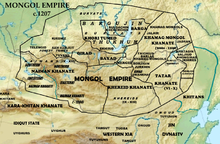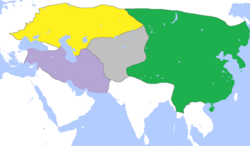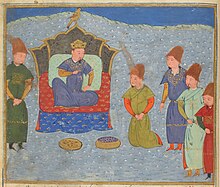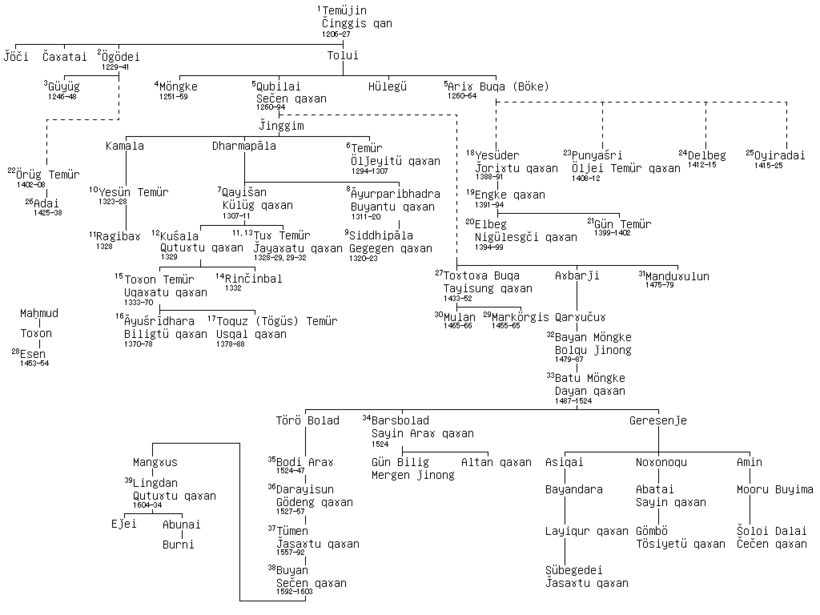Borjigin
| Borjigin ᠪᠣᠷᠵᠢᠭᠢᠨ Боржигин | |
|---|---|
| Country | Mongol Empire,Northern Yuan dynasty,Mongolia, China (Inner MongoliaandXin gian g) |
| Place of origin | Khamag Mongol |
| Founded | c. 900 AD |
| Founder | Bodonchar Munkhag |
| Final ruler |
|
| Titles | Khagan,Khan,Ilkhan,Noyan,Tsar |
| Estate(s) | Mongolia, Russia, Central Asia, Iran and China |
| Deposition | 1930 |
| Cadet branches | Jochids(Girays,Shaybanids,Tore),Yuan,House of Hulagu,House of Chagatai |

ABorjigin[b]is a member of theMongolsub-clan that started withBodonchar Munkhag[c]of theKiyatclan.[5]Yesugei'sdescendants were thus said to be Kiyat-Borjigin.[6]The senior Borjigids provided ruling princes forMongoliaandInner Mongoliauntil the 20th century.[7]The clan formed theruling classamong theMongolsand some other peoples ofCentral AsiaandEastern Europe.Today, the Borjigid are found in most of Mongolia, Inner Mongolia andXin gian g,[7]and genetic research has shown thatdescent from Genghis KhanandTimuris common throughout Central Asia and other regions.[according to whom?]
Origin and name
[edit]The patrilineage began with Blue-greyWolf(Börte Chino) and FallowDoe(Gua Maral). According toThe Secret History of the Mongols,their 11th generation descendant Dobu Mergen's widowAlan Guathe Fair was impregnated by a ray of light.[8]Her youngest son became the ancestor of the later Borjigid.[9]He wasBodonchar Munkhag,who along with his brothers sired the entire Mongol nation.[10]According toRashid-al-Din Hamadani,many of the older Mongolian clans were founded by members of the Borjigin —Barlas,Urud,Manghud,Taichiut,Chonos,Kiyat, etc. The first Khan of the Mongol was Bodonchar Munkhag's great-great-grandsonKhaidu Khan.Khaidu's grandsonsKhabul KhanandAmbaghaiKhan (founder of theTaichiutclan) succeeded him. Thereafter, Khabul's sons,HotulaKhan andYesugei,and Khabul's grandsonTemujin(Genghis Khan,son of Yesugei) ruled theKhamag Mongol.By the unification of the Mongols in 1206, virtually all of Temujin's uncles and first cousins had died, and from then on only the descendants of Yesugei Baghatur, his brother Daritai, and nephew Onggur formed the Borjigid.
According toPaul PelliotandLouis Hambis,Rashid al-Din Hamadanionce explained that "borčïqïn"designated in the Turkic languages a man with dark-blue eyes (اشهل,ašhal), and did so again without mentioning the said language, adding that Yesugei's children and the majority of their own children had had such eyes per coincidence, also recalling that the genie which had impregnatedAlan Guaafter her husband's death had had dark-blue eyes ( "ašhal čašm").[4]Abu al-Ghazi Bahadurlater paraphrased Hamadani by relating that Yesugei's eyes were dark-blue ( "شهلاšahlā"), that the Mongols ("Moɣol") called such eyes"borǰïɣïn"(بورجغن[11]), that his sons and most of their descendants had dark-blue eyes ( "ašhal"), and that one recognized thus in Yesugei's lineage the characteristic sign of the genie which had visited Alan Gua and had"borǰïɣïn"eyes, adding that the Arabs called"ašhal"a man whose iris ("bübäčik") was black, cornea white ("aq"), and whose limbal ring was red.[2]
History
[edit]
The Borjigin family ruled over theMongol Empirefrom the 13th to 14th century. The rise of Genghis Khan narrowed the scope of the Borjigid-Kiyad clans sharply.[12]This separation was emphasized by the intermarriage of Genghis's descendants with theBarlas,Baarin,Manghudand other branches of the original Borjigid. In the western regions of the Empire, the Jurkin and perhaps other lineages near to Genghis's lineage used the clan name Kiyad but did not share in the privileges of the Genghisids. The Borjigit clan had once dominated large lands stretching fromJavatoIranand fromIndo-ChinatoNovgorod.In 1335, with the disintegration of theIlkhanateinIran,the first of numerous non-Borjigid-Kiyad dynasties appeared. Established by marriage partners of Genghisids, these included theSuldus Chupanids,Jalayiridsin the Middle East, theBarulas dynastiesinChagatai Khanateand India, the Manghud andOnggiratdynasties in theGolden Hordeand Central Asia, and theOiratsin western Mongolia.
In 1368, during the reign ofToghun Temür(Emperor Huizong of Yuan), theYuan dynastywas overthrown by theMing dynastybut members of the family continued to rule over northern China and the Mongolian Plateau into the 17th century, known as theNorthern Yuan dynasty.Descendants of Genghis Khan's brothers,HasarandBelgutei,surrendered to the Ming in the 1380s. By 1470 the Borjigin lines were severely weakened, and the Mongolian Plateau was almost in chaos.
Post-Mongol Empire
[edit]
After the breakup of the Golden Horde, the Khiyat continued to rule theCrimeaandKazanuntil the late 18th century. They were annexed by theRussian Empireand the Chinese. In Mongolia, the Kublaids reigned asKhaganof the Mongols, however, descendants ofÖgedeiandAriq Bökeusurped the throne briefly.
UnderDayan Khan(1480–1517) a broad Borjigid revival reestablished Borjigid supremacy among the Mongols proper. His descendants proliferated to become a new ruling class. The Borjigin clan was the strongest of the 49 Mongolbannersfrom which the Bontoi clan proper supported and fought for their Khan and for their honor. The easternKhorchinswere under the Hasarids, and the Ongnigud, Abagha Mongols were under the Belguteids andTemüge Odchigenids.A fragment of the Hasarids deported to Western Mongolia became theKhoshuts.
TheQing dynastyrespected the Borjigin family and the early emperors married the Hasarid Borjigids of the Khorchin. Even among the pro-Qing Mongols, traces of the alternative tradition survived. Aci Lomi, a banner general, wrote hisHistory of the Borjigid Clanin 1732–35.[13]The 18th century and 19th century Qing nobility was adorned by the descendants of the early Mongol adherents including the Borjigin.[14]
Asian dynasties descended from Genghis Khan included theYuan dynastyof China, theIlkhanidsofPersia,theJochidsof theGolden Horde,theShaybanidsofSiberiaand Central Asia, and theAstrakhanidsof Central Asia. As a rule, the Genghisid descent played a crucial role inTatarpolitics. For instance,Mamaihad to exercise his authority through a succession of puppet khans but could not assume the title ofkhanhimself because he lacked Genghisid lineage.
The word "Chingisid" derives from the name of the Mongol conquerorGenghis (Chingis) Khan(c. 1162–1227 CE). Genghis and his successors created a vast empire stretching from theSea of Japanto theBlack Sea.
- TheChingisid principle,[15]or golden lineage, was the rule of inheritance laid down in the (Yassa), the legal code attributed to Genghis Khan.
- AChingisid princewas one who could trace directdescent from Genghis Khanin the male line, and who could therefore claim high respect in the Mongol,TurkicandAsiaticworld.
- TheChingisid stateswere the successor states orKhanatesafter the Mongol empire broke up following the death of the Genghis Khan's sons and theirsuccessors.
- The termChingisid peoplewas used[by whom?]to describe the people of Genghis Khan's armies who came in contact with Europeans. It applied primarily theGolden Horde,led byBatu Khan,a grandson of Genghis. Members of the Horde were predominantlyKıpchak—Turkic-speaking people rather than Mongols. (Although the aristocracy was largely Mongol, Mongols were never more than a small minority in the armies and the lands they conquered.) Europeans often (incorrectly) called the people of the Golden Horde "Tartars".
BaburandHumayun,founders of theMughal Empirein India, asserted their authority as Chinggisids. Because they claimed descent through their maternal lineage, they had never used the clan name Borjigin.
The Genghisids also include such dynasties and houses asGiray,House of Siberia,Ar begs,Yaushev family[16]and other.
The last ruling monarch of Genghisid ancestry,Maqsud Shah(d. 1930),Khan of Kumulfrom 1908 to 1930.
Modern relevance
[edit]The Borjigin held power over Mongolia for many centuries (even duringQing period) and only lost power whenCommuniststook control in the 20th century. Aristocratic descent was something to be forgotten in thesocialistperiod.[17]Joseph Stalin's associates executed some 30,000 Mongols including Borjigin nobles in a series of campaigns against their culture and religion.[18]Clan association has lost its practical relevance in the 20th century, but is still considered a matter of honour and pride by manyMongolians.In 1920s the communist regime banned the use of clan names. When the ban was lifted again in 1997, and people were told they had to have surnames, most families had lost knowledge about their clan association. Because of that, a disproportionate number of families registered the most prestigious clan name Borjigin, many of them without historic justification.[19][20]The label Borjigin is used as a measure of cultural supremacy.[21]
InInner Mongolia,the Borjigid or Kiyad name became the basis for many Chinese surnames adopted byethnic Inner Mongols.[12]The Inner Mongolian Borjigin Taijis took the surnameBao(Bào,from Borjigid) and inOrdosQi(Kỳ,Qiyat). Agenetic researchhas proposed that as many as 16 million men from populations as far apart asHazarasin the West andHezhe peopleto the east may have Borjigid-Kiyad ancestry.[22]The Qiyat clan name is still found among theKazakhs,UzbeksandNogaiKarakalpaks
Prominent Kiyads or Borjigins
[edit]
Rulers of theKhamag Mongol(11th century – 1206)
[edit]Emperors and rulers of theMongol Empire(1206–1368)
[edit]Genghis Khan's brothers
[edit]Rulers of the Khanates
[edit]
Post-Mongol EmpireGolden Horde(1360–1502)
[edit]Crimean Khanate(1441–1783)
[edit]Kazan Khanate(1438–1552)
[edit]Uzbek Khanate(1428–1471)
[edit]Kazakh Khanate(1456–1847)
[edit]Northern Yuan dynasty(1368–1635)
[edit]Ruler of the Tumed
[edit]Khalkha
[edit]Gallery
[edit]-
Toluiwith his wifeSorghaghtani Beki
-
Mengli Girayat the court ofBayezid II
-
KhalkhaBorjigin ruler Tsereng (Bác Nhĩ Tế Cát Đặc sách lăng,1672-1750). 18th century painting
Yuan dynasty family tree
[edit]Genghis Khanfounded theMongol Empirein 1206. His grandson,Kublai Khan,after defeating his younger brother and rival claimant to the throneAriq Böke,founded theYuan dynastyof China in 1271. The dynasty was overthrown by theMing dynastyduring the reign ofToghon Temürin 1368, but it survived in theMongolian Plateau,known as theNorthern Yuan dynasty.Although the throne was usurped byEsen Taishiof theOiratsin 1453, he was overthrown in the next year. A recovery of the khaganate was achieved byDayan Khan,but the territory was segmented by his descendants. The lastkhanLigdendied in 1634 and his sonEjei Khongorsubmitted himself toHong Taijithe next year, ending the Northern Yuan regime.[24]However, the Borjigin nobles continued to rule their subjects until the 20th century under theQing dynasty.[25][e]
Or in a different version (years of reign over the Northern Yuan dynasty [up to 1388] are given in brackets).
See also
[edit]- Family tree of Genghis Khan
- History of Mongolia
- Mongolian name
- List of medieval Mongolian tribes and clans
- Turco-Mongol
Notes
[edit]- ^A Middle Mongolian plural-suffix-thas been written about by Éva Csáki inMiddle Mongolian Loan Words in Volga Kipchak Languages.
- ^/ˈbɔːrdʒɪɡɪn/;Mongolian:Боржигин,romanized:Borzhigin,ᠪᠣᠷᠵᠢᠭᠢᠨpronounced[ˈpɔrt͡ɕɘkɘŋ];simplified Chinese:Bột Nhi Chỉ Cân;traditional Chinese:Bột Nhi Chỉ Cân;pinyin:Bó'érjìjǐn;Russian:Борджигин,romanized:Bordžigin;English plural:BorjiginsorBorjigid(fromMiddle Mongolian);[2][a]Manchuplural?:
 [3]
[3]
- ^TheSecret History of the Mongolstraces it back to Yesugei's ancestorBodonchar[4]
- ^According to H. H. Howorth, Mamai used the clan name Kiyad which is near to Genghisid lineage. However, he was not direct descendant of Genghis Khan.[23]
- ^Wada Seidid pioneer work on this field, andHonda MinobuandOkada Hidehiromodified it, using newly discovered Persian (Timurid) records and Mongol chronicles.
References
[edit]Citations
[edit]- ^Encyclopedia Britannica.William Benton. 1973. p. 726.
- ^abHistoire des campagnes de Gengis Khan,p. 119.
- ^Li, p. 97.
- ^abHistoire des campagnes de Gengis Khan,p. 118.
- ^Histoire des campagnes de Gengis Khan,pp. 118, 123.
- ^Histoire des campagnes de Gengis Khan,pp. 122–123.
- ^abHumphrey & Sneath, p. 27.
- ^The Secret History of the Mongols,chapter 1, §§ 17, 21.
- ^Franke, Twitchett & Fairbank, p. 330.
- ^Kahn, p. 10.
- ^"Abulghasi Bahadür Chani Historia Mongolorum et Tatarorum nunc primum tatarice edita auctoritate et munificentia illustrissimi comitis Nicolai de Romanzoff".1825.
- ^abAtwood, p. 45.
- ^Perdue, p. 487.
- ^Crossley, p. 213.
- ^Halperin, chapter VIII.
- ^Сабитов Ж. М. (2011)."Башкирские ханы Бачман и Тура"(in Russian) (Сибирский сборник. Выпуск 1. Казань ed.): 63–69.
{{cite journal}}:Cite journal requires|journal=(help) - ^Humphrey & Sneath, p. 28.
- ^Weatherford, p. xv.
- ^"In Search of Sacred Names".
- ^Magnier.
- ^Pegg, p. 22.
- ^"The Genetic Legacy of the Mongols", pp. 717-721.
- ^The History of the Mongols,part. II, D. II, p. 190.[full citation needed]
- ^Heirman & Bumbacher, p. 395.
- ^Sneath, p. 21.
Sources
[edit]- Atwood, C. P.Encyclopedia of Mongolia and the Mongol Empire.
- Crossley, Pamela Kyle.A Translucent Mirror.
- Franke, Herbert; Twitchett, Denis; Fairbank, John King.The Cambridge History of China: Alien Regimes and Border States, 907-1368.
- "The Genetic Legacy of the Mongols".American Journal of Human Genetics,72.
- Halperin, Charles J. (1985).Russia and the Golden Horde: The Mongol Impact on Medieval Russian History.Indiana University Press.ISBN0-253-20445-3.ISBN978-0-253-20445-5.
- Heirman, Ann; Bumbacher, Stephan Peter.The Spread of Buddhism.
- Histoire des campagnes de Gengis Khan(in French). E. J. Brill.
- Humphrey, Caroline; Sneath, David.The End of Nomadism?.
- "In Search of Sacred Names",Mongolia Today,archived fromthe originalon 2007-06-07.
- Kahn, Paul.The Secret History of the Mongols.
- Li, Gertraude Roth.Manchu: A Textbook for Reading Documents.
- Magnier, Mark (October 23, 2004)."Identity Issues in Mongolia".Los Angeles Times.
- Pegg, Carole.Mongolian Music, Dance & Oral Narrative.
- Perdue, Peter C.China Marches West.
- Sneath, David.Changing Inner Mongolia: Pastoral Mongolian Society and the Chinese State.
- Weatherford, Jack.Genghis Khan and the Making of the Modern World.Three Rivers Press.
Further reading
[edit]- Wada Sei hòa điền thanh.Tōashi Kenkyū (Mōko Hen)Đông á sử nghiên cứu ( Mông Cổ biên ). Tokyo, 1959.
- Honda Minobu Honda thật tin.On the genealogy of the early Northern Yüan,Ural-Altaische Jahrbücher, XXX-314, 1958.
- Okada Hidehiro cương điền anh hoằng.Dayan Hagan no nendaiダヤン・ハガン の niên đại. Tōyō Gakuhō, Vol. 48, No. 3 pp. 1–26 and No. 4 pp. 40–61, 1965.
- Okada Hidehiro cương điền anh hoằng.Dayan Hagan no senseiダヤン・ハガン の tổ tiên. Shigaku Zasshi. Vol. 75, No. 5, pp. 1–38, 1966.









